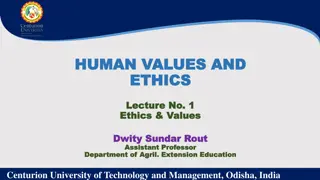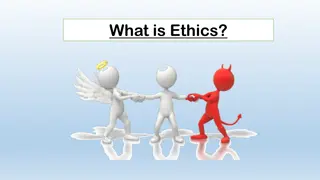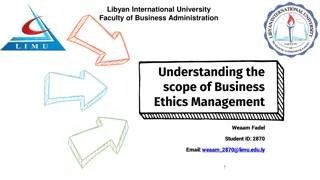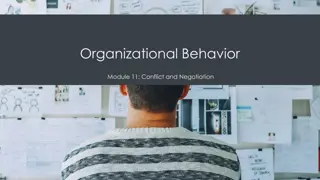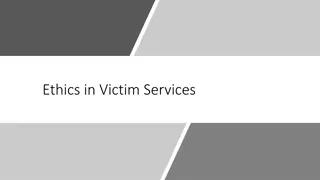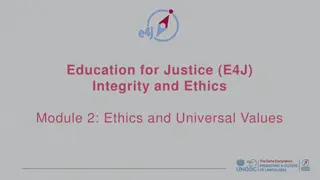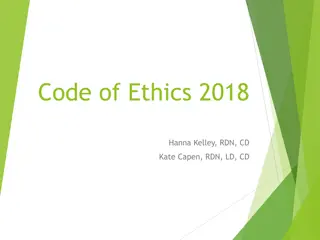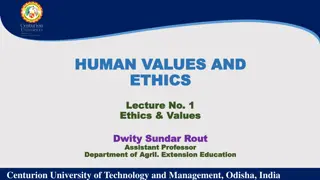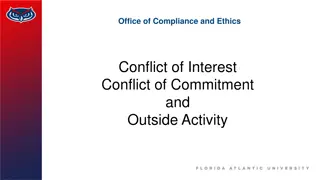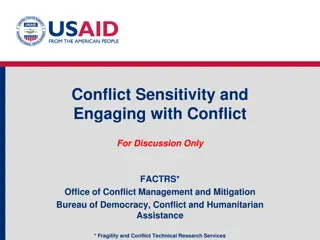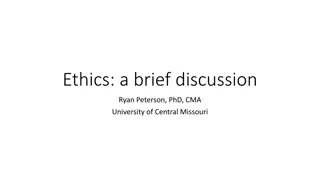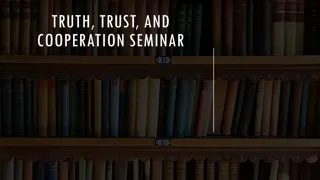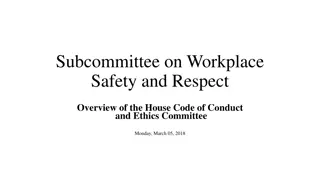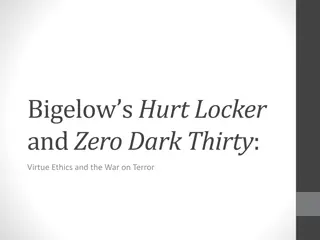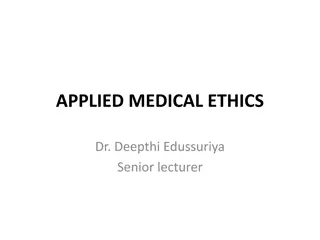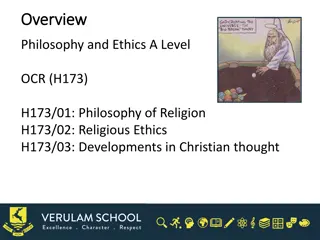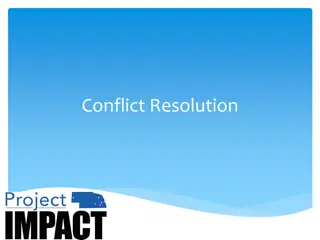Addressing Values Conflict in Ethics
When faced with conflicting values between home and host countries, it's crucial to navigate the delicate balance between relativism and ethnocentrism. Explore moral relativism and the 4 types of relativism to understand varying perspectives. Consider a balanced approach, incorporating principalism and DeGeorge's principles to make ethically sound decisions in diverse contexts.
Download Presentation

Please find below an Image/Link to download the presentation.
The content on the website is provided AS IS for your information and personal use only. It may not be sold, licensed, or shared on other websites without obtaining consent from the author.If you encounter any issues during the download, it is possible that the publisher has removed the file from their server.
You are allowed to download the files provided on this website for personal or commercial use, subject to the condition that they are used lawfully. All files are the property of their respective owners.
The content on the website is provided AS IS for your information and personal use only. It may not be sold, licensed, or shared on other websites without obtaining consent from the author.
E N D
Presentation Transcript
What should I do when values conflict What should I do when values conflict between home and host country? between home and host country? Two unacceptable and opposite approaches are: Relativism -there are no universal values Ethnocentrism -my culture has the right values
Moral Relativism Moral Relativism Standards of right and wrong are relative to different cultures, individuals, groups No universal moral standards Right action is not determined through critical thinking Our feelings and the views of others determine what is right Follow local norms and ignore your own values
4 types of Relativism 4 types of Relativism What is right is determined by: What is right is determined by: Culture of a country (Cultural) Each individual s values (Na ve) Our role in an organization (Role) Prominent groups in society (Social Group)
Ethnocentrism Ethnocentrism No matter the context Only My Values Matter Others are wrong I am right End of story
A balanced approach between two A balanced approach between two extremes extremes Relativism Principalism Ethnocentrism
Principalism Principalism Standards of right and wrong come from many sources (including self, group, culture) Moral reflection and dialogue is required because: a) Moral questions are complex no easy solutions b) Our decisions express and define our values c) We make decisions within a larger community to which we are responsible
DeGeorges DeGeorge s Principles Principles Do no intentional direct harm Produce more good than harm for host Contribute to host s development Respect human rights of employees Respect local culture (within limits) Work with government to create just institutions
Amoral Leadership Amoral Leadership Effective leaders are capable of attaining organizational objectives Ethics and values play no role in defining effective leaders Unable to distinguish between Adolf Hitler and Mahatma Gandhi
Amoral Leadership Theories Amoral Leadership Theories Great man and trait theories identifies the personality traits of leaders Psychodynamic theories studies the leaders and followers motivations for success Situational theories different situations demand different styles of leadership
Amoral Leadership Does Not Ask: Amoral Leadership Does Not Ask: Is the desired outcome desirable? Are the tools used ethically sound? Ethics Should followers know how the leader is motivating them? How can we distinguish a good leader from a bad leader?
Values Values- -Based Leadership Based Leadership Seeks to understand the values of leaders and followers The leader displays values (i.e. honesty, trustworthiness), and respects followers wants and needs In this way, the leader gains the trust and loyalty of followers who are empowered to achieve desired goals
Value Value- -Based Leadership Does Not Ask: Based Leadership Does Not Ask: Are the goals appropriate? Are the values, wants and needs of the followers right? Is it ever morally correct for a leader to withdrawal from the leadership role?
Ethical Leadership Ethical Leadership John W. Gardner and James MacGregor Burns describe what integrated, ethical leadership might look like in a business environment. The popular work: Leading from the Middle is an ethically grounded view of leadership.
Creating a Value Proposition Creating a Value Proposition and Delivering on it for Customers and Delivering on it for Customers marketing operations Makes Promises Delivers
Marketing Marketing Is fundamentally about the customer and meeting customer needs
Marketing Marketing without Focus on customer when there is pay-off Make as much money as possible Everybody markets product like this without Ethics Ethics
Marketing Marketing with with Ethics asks: Ethics asks: 1. Does your value proposition shape your brand and the value you deliver? 2. What does your marketing say about the kind of firm you are? 3. Do you consider core stakeholders in marketing campaigns and respect the law and basic moral standards? 4. Do you work to make sure your firm has the reputation to be successful over time?
Who Is Being Targeted? What Is Being Marketed? How Are We Marketing?
Who Is Being Targeted? Who Is Being Targeted? Segmentation, targeting, and positioning (STP) help managers analyze the market and to specify which customer will be served. Managers need to ask if the way they gather information is respectful to their customers and other stakeholders. e.g. the use of cookies on the Internet
Is it Ethical to Target Certain Is it Ethical to Target Certain Groups? Groups? Targeting less-advantaged or vulnerable portion of the population Marketing products to children Subprime mortgages being targeted to individuals of lower economic position
What Is Being Marketed? What Is Being Marketed? The product should serve the needs of the customer e.g. selling pesticides to less developed countries can result in harm The price should be fair e.g. drugs can be priced too high for some consumers especially HIV/AIDS medications
Managers Need to Ask: Managers Need to Ask: 1. Does the product do what we claim it does? (i.e. Are we being truthful?) 2. Does the product meet a legitimate customer need, or does it foster a want? 3. Are there certain products (i.e. harmful products) that should not be made?
How Are We Marketing? How Are We Marketing? The tactics used to reach customers need to be examined Deceiving supply chain partners e.g. firms may give false information or offer questionable incentives to get shelf space at a Wal- Mart store Using images and promotions that are deceptive or disrespectful to stakeholders
A New Understanding Of Marketing A New Understanding Of Marketing Does more than sell products Is the vehicle through which an organization tells the story of its product, services, or core values Builds a foundation of trust and consideration between the firm and the consumer
Operations Operations Is the process by which firms create and deliver values to their customers
Operations Operations without without Ethics Ethics Uses any means necessary Struggle with suppliers Employees treated like cogs in a wheel
Operations Operations with with Ethics asks: Ethics asks: 1. Are employees a critical asset I have to invest in to create quality and outstanding customer service? 2. Are suppliers considered stakeholders with whom I should develop a close relationship? 3. Are shared goals and values, trust, and shared responsibility among supply chain members important to the firm s operations?
The Quality Movement The Quality Movement W. Edwards Deming W. Edwards Deming Do things right the first time Management commitment to quality -Empower employees All areas need to work together for customer satisfaction
Key Facets of Operations Key Facets of Operations Internal Organization Measurement Employees if you can t measure it, you don t know how you are performing Interfirm Cooperation Culture Organization Structure
Internal Organization Internal Organization Employees get them committed to the firm s goals Interfirm Cooperation across all functional areas of the firm Culture cultivate people s willingness to put aside self-interest to work cooperatively for the good of the firm Organizational Structure a flatter, more decentralized structure
Supply Chain Management Supply Chain Management The supply chain involves all activities that move goods from the raw material stage to the end user Stakeholders include: employees, suppliers, vendors, banks, distributors, transportation companies Supply Chain Management refers to the management of all elements of the supply chain
Importance of Close Relationships With Importance of Close Relationships With Supply Chain Partners Supply Chain Partners By developing trust, cooperation, and goal alignment supply chain partners will: Look out for firm s interest Share information Bargain in good faith Invest in products that could put them at risk if firm were to pull its business Toyota s close relationships with its suppliers allow Toyota to carry almost no inventory of parts
In 2007 Mattel recalled 18.2 million toys made in China because of dangerous lead paint. Rather than blaming Chinese suppliers, Mattel made sure the stakeholders in the supply chain were treated fairly.
Special Challenges In The Supply Chain Special Challenges In The Supply Chain Responsibility for International Labor Issues sweatshops, child labor, low wages, treatment of workers Responsibility When Things Break Down Ford SUV tires blew out making it more likely for drivers to lose control. Ford and Firestone (the tire maker) blamed each other poisoning their longstanding relationship.
A New Understanding Of Operations A New Understanding Of Operations No longer view operations as a disconnected and mundane activity to get the product out It s about how firms deliver value to their stakeholders through their production facilities, supply chain, strategic vision, and employees
High Performance Businesses (HPB) High Performance Businesses (HPB) do an outstanding job of developing a brand a distinct set of images and associations in the customer s mind about the firm s value proposition and then work relentlessly to create the capabilities to deliver that value to the customer in a highly efficient and timely manner.
Management Chapter 8
Managing: Managing: putting together an array of resources of the firm to execute their strategy and deliver value to the marketplace
Managers: Managers: those in the middle of an organization those in the middle of an organization Top Leaders Managers Employees
Management Management without Getting stakeholders to do what the firm wants in order to maximize profits without Ethics Ethics Workers are resources to generate bottom line benefits
Management Management with with Ethics Ethics Creates communities where the value proposition of the firm inspires individuals to put forth their best effort collectively creating value for all stakeholders Treats others as human beings who deserve respect and consideration
Historical Perspective Historical Perspective Taylor Deming Maslow MacGregor Scientific Total Quality Management Hierarchy Theory X people dislike work Theory Y people like to work Management Of Needs Workers know the best on how to improve production Design work to make workers as productive as possible Self-esteem & Self- actualization
Hierarchy & Relationships between workers and superiors The Individual What motivates them Managing Groups/Teams Enterprise (Organization) Small-group dynamics See the big picture
The Individual The Individual How to Motivate How to Motivate Needs Theory (ERG) Existence needs (food, shelter) Relatedness needs (connection to others) Growth needs (develop & use our talents) Equity Theory Perception that employer if fair/equitable
Hierarchy & Relationships Hierarchy & Relationships Authority Psychological Contract Gender
Hierarchy Hierarchy Relationships with Authority Relationships with Authority People tend to listen to authority out of respect, fear, belief in their expertise Managers have to find ways to get people to question authority
Role of Gender in Relationships Role of Gender in Relationships Men & Women are Different Men & Women are Different See communication in terms of independence Lead with positional power and status See communication in terms of intimacy Lead with charisma and personal power


